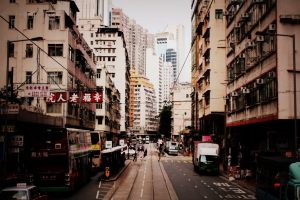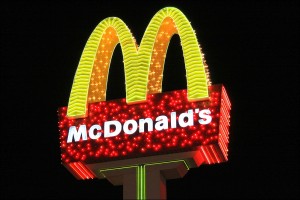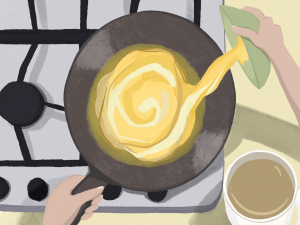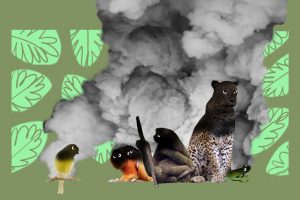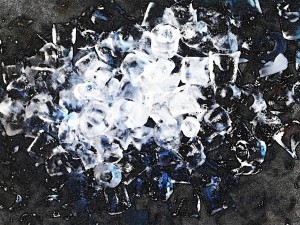
Diet Democracy
by Nat Cheung | March 30, 2021
In 2019, Lung Mun Cafe and Hung Hom Cafe stood side by side on Cameron Road. Both were typical chachaanteng diners, serving charsiu spaghetti soup and other edible remnants of Hong Kong’s colonial era. There were always long queues in front of Lung Mun; Hung Hom went out of business by the end of the year. By June 2020, Lung Mun started getting less footfall too. A few blocks away on Hau Fook Street, another diner, Kwong Wing, was dishing up plates of their specialty to crowds: steamed rice topped with three fried eggs, their sunny yellow yolks staring back at you.
Yellow is the colour of the pro-democracy camp in Hong Kong, originating in the yellow umbrellas used to block out tear gas and rubber bullets at the 2014 protests for universal suffrage. On the other side of the political colour spectrum is blue: pro-police, pro-government, and, by extension, pro-China. It comes from the colour of police uniforms. As companies started firing employees for protesting against a contentious extradition bill in June 2019, the yellow camp issued a call to arms to support allies in affected industries. An intricate boycotting system, whereby businesses are colour-coded into the yellow and blue ‘economic circles’, was thus born. As the pandemic and the new National Security Law (NSL), which criminalises acts of protest against China, have brought demonstrations to their cessation, the market has replaced the streets as the site of protest. Money has overtaken Molotov cocktails, rubber bullets, and tear gas as the weapon of choice for both sides.
The restaurant and retail industries – with their large number of small, independently run players – are the main sites of this proxy war. Without having to worry about offending investors, these small businesses can express their political stance more freely. Before the NSL, yellow shops generally liked to show that they were yellow to attract customers. There, you would find posters, pamphlets and resistance mascots like Pepe the Frog and LIHKG pig (an emote on a local online forum). If they’re ‘dark yellow’, staunchly pro-democracy and unafraid of police inspection, these shops might even have a ‘Lennon wall’ where people write encouraging messages on Post-it notes for fellow supporters.
Since state media accused the yellow economic circle of promoting treason, most of these decorations have been torn down. Now, consumers rely on mapping apps like Wolipay, which indicate the ‘colours’ of shops, to navigate their choices. ‘Wolipay’ is a play on the Cantonese term ‘wo lei fei’, an abbreviation of ‘peaceful, rational, and non-violent’: a slogan for democratic protest in Hong Kong. More noteworthy still, ‘wo lei’ is a homonym for ‘with you’. Companies are expected to fight alongside customers: the creator of Wolipay stresses that his two key conditions for labelling a restaurant yellow are that they have participated in strikes and have given protestors free food during demonstrations. Business boomed for Lung Mun Cafe after they did both. By contrast, after the daughter of the co-founder of Hong Kong’s biggest catering company, Maxim’s, condemned protestors in front of the UN Human Rights Council in June 2019, there was a mass boycott of all restaurants and brands operated by the firm. Maxim’s sales went down by 29%, and they lost 50 million USD in the first half of 2020.
Although yellow restaurants may have put a dent in blue earnings, the effectiveness of the boycott should not be overestimated: they are, after all, fighting against big restaurant chains backed by Chinese money. The restaurant and the retail industries accounted for only 4.2% of local GDP in 2018. Hong Kong’s four key industries – finance, tourism, trading, and logistics – remain largely unaffected by the boycott. What is truly radical about the yellow economy is that before its existence, there was only ever a blue economy. Reliance on China and the city’s pro-Beijing establishment for material and financial resources was very much a given, and still is. But this wild ambition of financial freedom, of a profoundly ‘made in Hong Kong’ economy, is fairly novel. Even after the 2014 Umbrella Revolution, which first divided the city into blue and yellow, there had barely been any bottom-up economic action manifesting the same spirit. It’s not common for Hong Kongers to be so optimistic.
The yellow camp’s ostensible optimism arguably comes from a place of defeat. By June 2020 the prospect of universal suffrage was extinct. Moreover, the creation of the NSL meant that crimes of “secession, subversion, terrorism and collusion with foreign forces” became punishable by life in prison, with Beijing yielding the power to interpret the law. Its deterrent effect has certainly worked – there have been no major protests since. Some businesses, including Lung Mun Cafe, have since quit the yellow circle. Concerned by the clampdown on civil liberties, some foreign firms are leaving Hong Kong altogether, with major financial companies like Deutsche Bank relocating their Asia operations to Singapore. “We’re closer to China,” says Stanley Wong, an ex-banker turned finance columnist, “but we’re further away from the world.” This is a shift which has ironically heightened the anti-China sentiment in Hong Kong. The NSL seems to portend the loss of the city’s status as a global financial centre, and the livelihoods that come with it. This sentiment means that, however implausible it may be to break away from China’s financial hold, many people are now indifferent to the pragmatic possibilities still on offer. If, or when, their businesses get shut down, yellow entrepreneurs can at least say that they stuck to their guns while it lasted. The majority of dissidents know that buying a ham sandwich from a yellow cafe won’t make Hong Kong democratic, but the visceral intensity of their political defeat, coupled with the COVID recession, has translated into unmatched levels of collaboration in this hyper-capitalist city.
To the majority of its partisans, ‘yellowism’ is a moral cause. The yellow brand of ethical consumerism stems from what its followers identify as Hong Kong’s core values as laid out in the region’s constitution: freedom of expression and judicial independence. Compared to the blue economy, comfortably propped up by rich Chinese corporations, smaller yellow businesses urgently need extra financial support. Consumers are therefore mobilising their spending power because they believe in the goodness of those values. For business owners, defending those values is their corporate social responsibility.
Unsurprisingly, the blue narrative denounces the yellow claim to a moral high ground, and instead interprets the boycott as an unethical project depriving blue business owners of their livelihoods amidst a global recession. Although the boycott is a non-violent form of protest, it has spawned numerous cases of vandalism, or to use a popular euphemism, the ‘refurbishment’ of blue shops. When the coronavirus first hit, Kwong Wing Catering banned all Mandarin speakers (which to them equalled Mainlanders) except for the Taiwanese. Patrons had to show their Hong Kong identity card and even recite a protest slogan (often in Cantonese couplets) at the door to be allowed in. The government’s favourite argument against the yellow economy is its potential for division and discrimination, and here Kwong Wing serves as a perfect example for their rhetoric.
Vandalism and outright discrimination hardly help the yellow cause, especially when it wants to be an ethical one. In the eyes of the militant sect, drastic measures have to be taken if a democratic society is to be constructed. In contrast, since over ten thousand protestors have been arrested, and almost every candidate who ran in the 2020 democratic primaries charged with subversion, the ‘wo lei fei’ majority feels the need to keep the boycott a purely bloodless operation, preserving what appears to be the last battlefront of the movement. Yet the oddity and even chutzpah of the yellow circle is that it is as anti-corporate as it is anti-blue — it is scarcely interested in easy targets like small blue businesses, and so they are rarely the victims of these attacks. Especially since the yellow economy was originally founded to hire protestors sacked from banks and airlines for their political activities, the initiative is partly revenge against the corporate world. Independent blue shop owners have less to do with it.
Yet, the yellow label has itself become commercialised, at times nothing more than a marketing niche. Democracy sells: Maxim’s, driven by profit, has quietly created a number of new restaurants, refraining from endorsing them on the back of the firm’s name to masquerade them as neutral, even yellow, enterprises. Anxieties about the commodification of democracy have made the public’s criteria for yellowness more and more trenchant. Every day, online forum users pump out gossip on shops’ political leanings, often with the intention of revoking their yellow label for something as trivial as staff having a poor attitude towards yellow patrons. At the same time, political scientist Simon Shen argues that there’s no need to fact-check the leanings of businesses and certainly no need to witch-hunt fake yellow firms. Ultimately, such businesses are promoting the pro-democracy brand, adding to the pressure that the economic circle seeks to put on the government. He encourages the acceptance of “two-faced” individuals who are privately yellow but work for blue enterprises, as they can still make use of their rivals’ resources to bolster their own by putting their income back into the yellow economy or donating to protest funds. Protestors are pressed to look past these inevitable ambiguities and focus their energy on ensuring that money goes back to fund the democratic cause in the cycle.
Beyond the restaurant and retail industries, it seems as though the future of the yellow economy rests on whether it can widen its scope to Hong Kong’s lifeblood sectors like finance. Last August, supporters boosted shares in the pro-democracy media company Next Digital by over 340% on the day its founder got arrested under the NSL. Stanley Wong was one of those who profited, before donating his earnings to student protestors. He tells me, however, that he has little faith in a yellow finance circle: “I can’t even think of a first step, to be very honest. You wouldn’t be a very good banker if you weren’t conservative.” For Wong, the establishment has an untouchable hegemony over all property, resources, and networks that lead to social mobility, by which the city’s four main industries are safeguarded. “Without a purely yellow supply chain, the economic circle cannot claim legitimacy.” The only other realm that the circle could viably access, though not without facing powerful Chinese competitors, is manufacturing. But as the “made in Hong Kong” label is still hard to come by, the yellow economy remains static, unable to stretch its radius.
Despite his general scepticism, Wong has some confidence in the resilience of yellow restaurants. He calls the government’s draconian COVID measures against the whole catering industry a “scorched-earth” policy that resulted from their inability to clamp down on yellow joints whilst also keeping the pandemic under control. “The policy might kill off some players in the short term, but entry barriers in the food industry are low, especially since the pandemic has pushed down rent prices.” He predicts a rebirth of yellow restaurants after the lockdown, whilst tourism, airlines and logistics, industries equally hit by COVID, cannot be repaired so easily. Nonetheless, they will be reborn in a post-NSL Hong Kong, where the main issue will be survival rather than ideological expression. “The old concept of the yellow economic circle has collapsed, but people still remember which ones donated to funds and which ones helped them through protests. The circle only really exists in people’s memories these days.”
As it stands, the yellow economy cannot prove to big companies that Hong Kong and its democratic allies might be a more lucrative market than Mainland China. Yellow businesses still operate in a legal grey area, and they are fully aware of the implications. Regardless, the phenomenon has sent a resounding message to the government, as well as Beijing, that protestors are persistent, and always adapting. As the introduction of the NSL has spurred a new wave of emigration, the yellow economic circle has spread with the diaspora, finding new hubs overseas. Colour-coded maps for Hong Konger-owned businesses have surfaced in major cities in Canada, the UK, and the US. Risking accusations of “foreign collusion”, a number of yellow online shops and food delivery services have moved their backend operations to Taiwan so that they can hire exiled protestors. The bigger the circle, the higher the possibility of a total crackdown; but with every new restriction also comes new forms of protest. Dining on Kwong Wing’s fried eggs is not the same as occupying the city centre for three months, or marching on the streets with two million allies, or storming the Legislative Council, but it is a show of solidarity paid out of one’s own pocket. It’s almost a stand-in revolution for what it cannot be.∎
Words by Nat Cheung. Art by Alisa Musatova.
